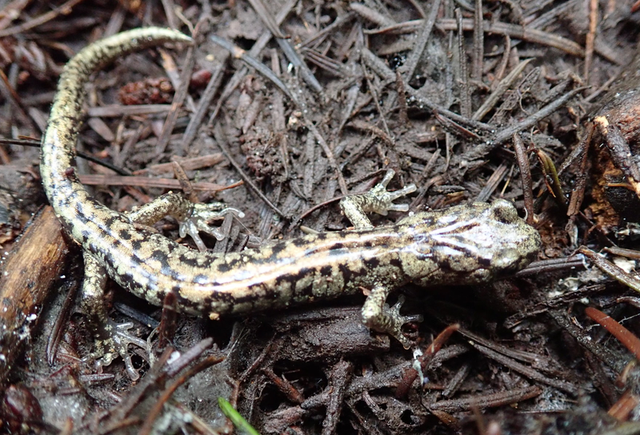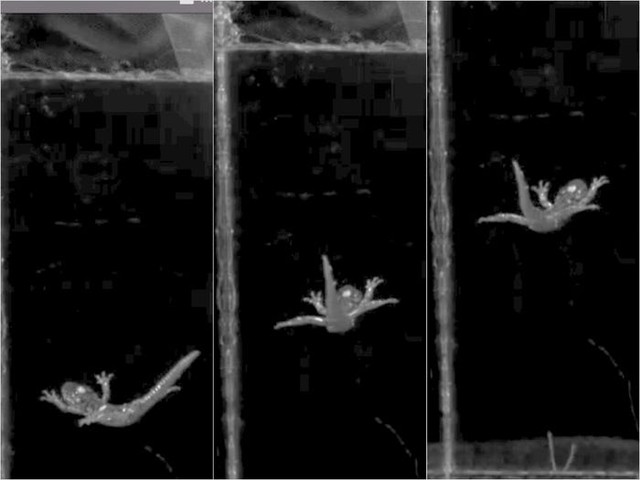The flying salamanders that live on top of the tallest tree in the world
Looming behind the mist-covered coastline of Redwood National Park in Northern California, USA, one can see the silhouette of a redwood tree (Sequoia sempervirens).
According to the Guinness Book of World Records, this giant redwood tree called Hyperion is the tallest tree in the world. In 2019, its measured height from base to tip was 116.07 meters. With this number, the height of the Hyperion tree in California should be equivalent to a 35-story building.

The tree is 800 years old. You can see its shadow, but the path to Hyperion is always hidden. That’s because people want to protect this tree against the human chainsaw. For a long time, coastal redwood has always been the target of loggers.
And when a redwood is brought down. Not only is it dead. The creatures that rely on these giant trees have also lost their homes. On it is a special species of salamander that scientists are studying.
They called them Aneides vagrans, or wandering salamanders.
The flying salamanders
They are the subject of research by Christian Brown, a doctoral candidate at the University of South Florida (USF). For the past few years, he has been involved in a project to study the wandering salamanders that live in the redwoods of California.
The project, founded 20 years ago by James Campbell-Spickler, now director of the Sequoia Park Zoo in Eureka, brings together researchers, conservationists and non-profit organizations interested in salamanders. wandering Aneides vagrans.
In it, they often have to climb to the top of the redwood trees, hundreds of meters above the ground to mark and tag the iguanas.

The salamander Aneides vagrans usually lives in stilts overgrown with moss and ferns of redwoods.

Climbing to their habitat height is already hard, the job of marking them is even harder.
The salamander Aneides vagrans usually lives in stilts overgrown with moss and ferns of redwoods. There was a rotten vegetation, but the salamander’s favorite home. Climbing to their habitat height is already hard, the job of marking them is even harder.
Whenever Brown lightly touched a branch, or almost caught an iguana, they didn’t hesitate to jump out of his hand to fall to the ground.
And at 116 meters above the ground, these salamanders somehow survived. Curious about the wandering salamander’s ability to parachute, Brown and his colleagues took some of them back to the laboratory to study.
They put them in a wind tunnel to simulate a free fall. A camera with a speed of 400 frames per second was placed there to record the salamander handling its fall. Research has finally revealed the mysteries of this parachute salamander.
Unlike flying squirrels, gliders and a species of gecko that have flaps of skin on their legs to help them glide through the air, the salamander Aneides vagrans was not created with any tools to aid in the jump.
Instead, they rely solely on their masterful body control skills. “During the skydive, these salamanders have very good maneuverability” said Brown.They can flip people. They can turn themselves over if upside down. They can maintain that skydiving posture and adjust their tails up and down to perform horizontal maneuvers. The level of control is very impressive.”
The salamander Aneides vagrans shows off its parachute skills in the wind tunnel
Professor Robert Dudley, an expert in the study of flight animals at the University of California, Berkeley added: “What struck me when I first saw the video was that they (these salamanders) moved so smoothly — there were no interruptions or disturbances in their movements, they were just completely floating in the air. gas.
That, to me, implies that the behavior must be something ingrained in their motor reflexes. How often the salamanders had to fall for this behavior to become a natural selection for them.
And it’s not just a passive parachute, they don’t just jump to the ground. The salamanders are also making obvious horizontal movements, which is what we call gliding.”
The flying and landing skills of the salamander Aneides vagrans
Back to the wind tunnel, to highlight the flight ability of the salamander Aneides vagrans, the scientists brought three other salamander species with similar bodies, A. lugubris and Ensatina eschscholtzii, to compare. compare.
They found that Ensatina eschscholtzii (forest-dwelling), A. lugubris (lower-altitude tree-dwelling) and A. flavipunctatus (mixed-dwelling) did not possess such skillful skydiving skills. Aneides vagrans.
“We call it inefficient motion, because they’re not really gliding, they’re not moving horizontally, they’re just hovering in the wind tunnel.“, Brown said.
How the salamander Aneides vagrans navigates horizontally through the air
In contrast, Aneides vagrans salamanders have spent their entire lives living only in the tops of tall trees, so they know how to effectively parachute. Scientists analyzed thousands of frames of Aneides vagrans’ 10-second falls to understand its skill.
Accordingly, this salamander often flexibly uses both legs, body and tail to navigate in the air. They usually fall at a steep angle of only about 5 degrees from the vertical, but when they need to change their torso to parallel to the ground, they simply need to adjust the position of their toes and feet.
By adopting this parachute pose, the salamander Aneides vagrans can reduce its vertical drop speed by up to 10%. “Wandering salamanders have large feet, long legs, and flexible tails. All of these things benefit their aerial navigation behaviour,” Brown said.
So while they don’t really have a dedicated aerodynamic control unit (like the flaps of skin found in flying squirrels, for example), this salamander is adept at flying. The scientists explain that the salamander Aneides vagrans learned skydiving skills from their high-altitude living conditions.
For a salamander only about 10cm long, crawling between a redwood tree up to 116 meters tall is a survival risk for them. They can be spotted by predators, suffer from dry skin and even run out of energy.
So Aneides vagrans opted for a one-way migration. They only crawl from low branches to rake branches, and when they need to crawl from high branches to low branches, they will choose to parachute.

“Let’s say you’re just a five-gram salamander, and then you’ve managed to climb the tallest tree on Earth. You must be exhausted. You’ve used up all your energy. So So if you want to go down, why walk? You won’t want to walk down, you’ll want to use that gravity elevator.”Brown said.
Since Aneides vagrans can navigate through the air, they can choose any low branch below to land. Because they are very light and often choose to land on rotten wood, the Aneides vagrans salamander is almost never hurt after its landing.
“This salamander’s ability to fly is a novelty, something unexpected in a group of animals that we thought we’d thoroughly studied.” said Associate Professor Dudley.It shows how evolution required an arboreal animal to develop the ability to fly in the air, even without wings.”
Studying this salamander not only helps us understand the evolutionary mechanism of animal diversity, but also helps to lift a curtain on the ecology of the redwood tree, the tallest plant on the planet.
Refer Businessinsider, Phys, Livesicence
at Blogtuan.info – Source: genk.vn – Read the original article here
